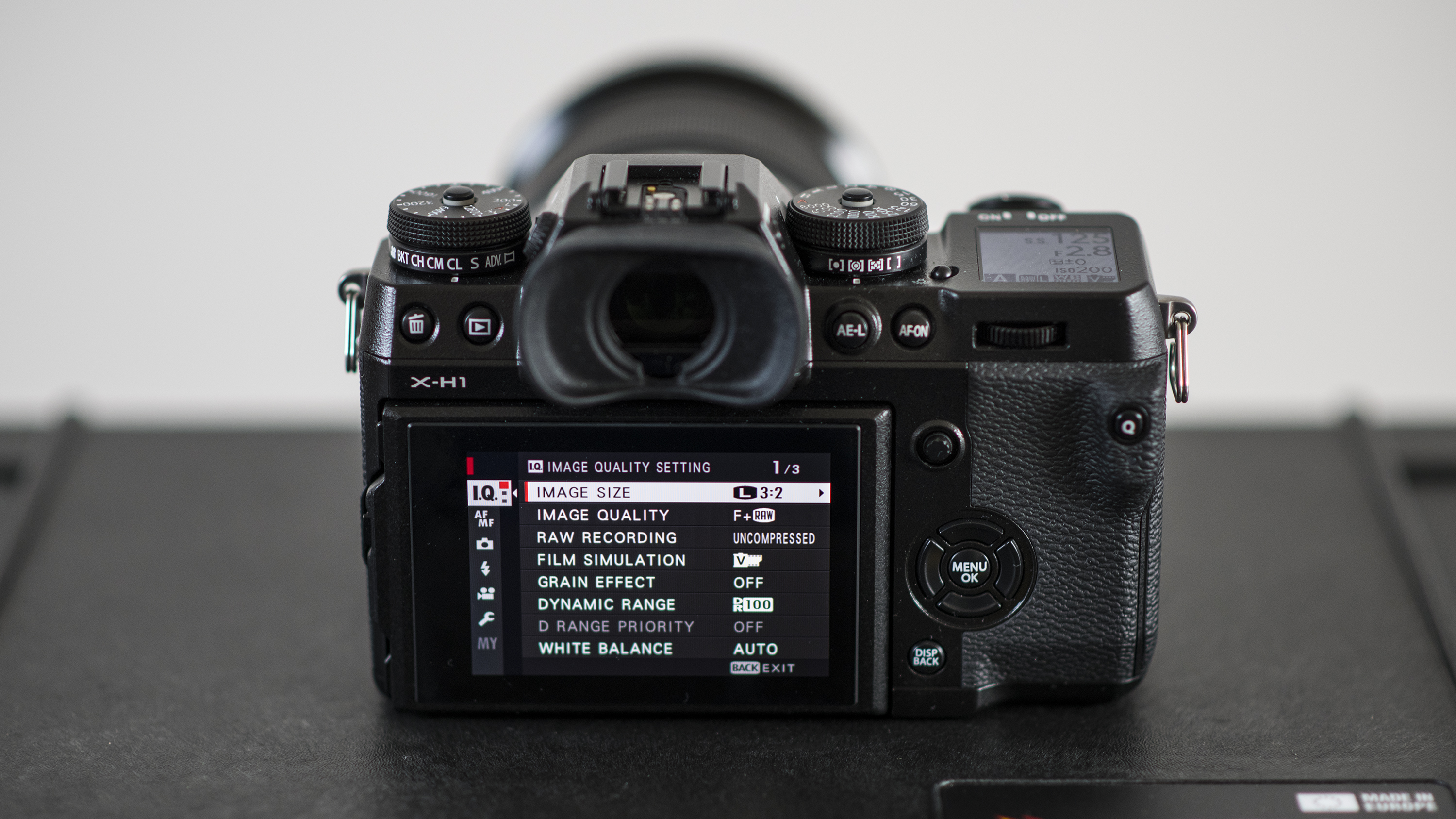Why you can trust TechRadar
Build and handling
- Dedicated AF-On button
- Much more pronounced grip than X-T2
- 1.28-inch LCD on top plate
As you'd expect for a camera aimed at serious enthusiasts and pros, the X-H1 is both dust-proof and water-resistant, while it's also designed to operate in temperatures as low as -10C. It's similar to the X-T2 in these respects, but to underline the X-H1's pro credentials the magnesium alloy used for the shell is 25% thicker than that used in the X-T2, and it sports a high-quality scratch-resistant coating.
The design of the X-H1 is a fusion of the X-T2 and the medium-format GFX 50S, with the most notable feature taken from the latter camera being the pronounced handgrip. This gives a much more satisfactory grip than the X-T2, especially if you're going to be shooting over long periods.
Another feature borrowed from the GFX 50S is the 1.28-inch LCD on the top of the camera. This displays all key shooting information, but it does come at the expense of the dedicated exposure compensation dial on the X-T2; instead there's a little exposure comp button next to the shutter release, and, just as we found when shooting with the GFX 50S, it's a tad awkward to use this in conjunction with the rear command dial.



Current X Series users, though, should feel right at home with the controls of the X-H1, with dedicated dials for ISO and shutter speed (both featuring locking buttons to prevent accidental movement), along with switches for drive modes and metering.
As we've come to expect with an X Series camera, the X-H1 is highly customizable, with the segments of the four-way control pad on the rear, as well as the dedicated function buttons, all capable of being assigned different functions via the menu.
As we've seen on recent X Series cameras, the X-H1 benefits from a small focus lever, while there's now a dedicated AF-On button on the rear of the camera for back-button focusing, a technique many photographers swear by – although if we're being hypercritical its positioning could do with shifting about 5mm to the right so the thumb falls more naturally on it.
Thanks to the re-designed shutter mechanism with improved damping, anyone who's shot with the X-T2 (or other X Series cameras) will instantly notice how much quieter the shutter is when triggered. The new feather-touch shutter button can take a little getting used to, as it's incredibly sensitive, but once you've got to grips with the hair trigger on the X-H1 you'll find it a welcome addition.
Sign up for breaking news, reviews, opinion, top tech deals, and more.
Autofocus
- Tweaked version of the AF system used in the X-T2
- 91-point phase-detect AF system
- 5 AF-C custom settings to help focus tracking
The Fujifilm X-H1 uses the same hybrid autofocus system (featuring both phase- and contrast-detection AF) as the X-T2, but Fujifilm has tinkered with the AF algorithm to enhance the performance further, while it's also improved the sensitivity of the phase-detection AF; it's now sensitive down to light levels as low as -1EV, compared to -0.5EV on the X-T2, and this is complemented by the -3EV sensitivity of the contrast-detection system.
Furthermore, if you use or are planning to use teleconverters with moderately slow lenses, such as the XF100-400mm f/4.5-5.6 R LM OIS WR, the good news is that the minimum aperture has been expanded from f/8 to f/11 on the X-H1, allowing phase-detection autofocus to be used at slow apertures.
The autofocus system in the X-H1, then, offers 91 phase-detect AF points arranged to provide decent coverage across the frame
The autofocus system in the X-H1, then, offers 91 phase-detect AF points arranged to provide decent coverage across the frame, while it's possible to have a total of 325 AF points at your disposal thanks to the contrast-detect AF points coming into play. However, it's only possible to access all 325 points in Single focus mode – switch to Continuous (AF-C), and while the contrast-detect points support AF acquisition, they aren't selectable.
As on the X-T2 there are five AF-C presets to choose from depending on how your subject is moving in the frame, how fast it's moving, and where in the frame you want the camera to place bias for focusing. These three parameters are called Tracking Sensitivity (how long the camera waits before switching focus), Speed Tracking Sensitivity (determines how sensitive the tracking system is to changes in subject speed) and Zone Area Switching (whether bias is to the centre, auto or front), and as well as the five presets there's also a custom setting allowing you to refine the three variables yourself.
The AF system performs very well for static subjects, with focusing both quiet and quick (we tested the X-H1 with Fujifilm's 16-55mm f/2.8 standard zoom). Switch to continuous AF and the tracking system is still very competent – we found that it could happily track fairly predictable subjects, although it will struggle when movement becomes a bit more tricky to judge.
There's still room for improvement – the X-H1's AF system doesn't quite have the sophistication of the 693-point AF system in the (albeit slightly pricer) Sony Alpha A7 III, or the excellent 153-point AF system in the Nikon D500.
Current page: Build, handling and AF
Prev Page Introduction and key features Next Page Performance and image quality
Phil Hall is an experienced writer and editor having worked on some of the largest photography magazines in the UK, and now edit the photography channel of TechRadar, the UK's biggest tech website and one of the largest in the world. He has also worked on numerous commercial projects, including working with manufacturers like Nikon and Fujifilm on bespoke printed and online camera guides, as well as writing technique blogs and copy for the John Lewis Technology guide.

